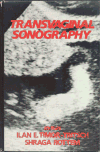All the members of our department used the new ultrasound probe and became quite proficient and experienced in its use; the result was far better diagnoses of female pelvic diseases. Today the obstetrical and gynecologic literature makes it quite clear that it is with thanks to the use of transvaginal sonography that a new chapter was written in evaluating the female pelvis3 and fetal anatomy in the first half of pregnancy; this achievement was made in the Department of Obstetrics and Gynecology here at Rambam Medical Center.4,5 Nevertheless, in the beginning, getting a paper published could by no means be assumed.
Our first article written about use of the transvaginal transducer was submitted to the Journal of Ultrasound in Medicine (under the editor George Leopold) and rejected with the comment: “Interesting use of ultrasound, however this is only a descriptive article without data.” However, the exact same article was accepted several weeks later by Frederick Zuspan, then the chief editor of the leading obstetrics and gynecology journal, the American Journal of Obstetrics and Gynecology.2
The use of the transvaginal probe provided us with the first detailed description of the fetal brain in the first trimester.6 We also used this technique for guided puncture procedures of different targets in the pelvis and fetus.7 I can name almost all of those who, during those years, worked in our department and contributed both directly and indirectly to developing the concept of evaluating fetal anatomy between 12 and 16 weeks of pregnancy.
Another important contributor to the acceptance of transvaginal ultrasound was Dr Moshe Bronshtein, who promoted this new scanning route and raised it to a whole new level by applying it to imaging first-trimester fetuses; he authored and co-authored more than 30 articles on the subject. One of the first articles that applied the transvaginal scanning route was significant for defining the two kinds of nuchal lesions of the first-trimester fetus.8
As this technique caught, I and my colleague, Shraga Rotem, decided to compile more than a dozen of the more noteworthy articles that dealt with the—then—new uses for the transvaginal ultrasound probe. The result was publication of the first book on the subject, entitled Transvaginal Sonography9 (Figure 2). The book was published in 1987, and each chapter was written by staff of Rambam’s Department of Obstetrics/Gynecology (Figure 3). Encouraged by the interest of obstetricians and gynecologists worldwide in our first edition, we published the second edition in 1991.
 | Figure 2 The First Edition of the Book Transvaginal Ultrasound by Ilan E. Timor-Tritsch and Shraga Rottem (1987). |
 | Figure 3 The Contents and Contributors Pages of Transvaginal Ultrasound (1987) with the Names of the Co-authors and Members of the Department of Obstetrics and Gynecology at Rambam Hospital. |
Use of the vaginal ultrasound probe enabled us to make a reliable diagnosis of placenta previa, or to rule it out, without endangering the patient or causing bleeding. Our paper on the first use of a transvaginal probe in the above setting was submitted in 1988 to the British Journal of Obstetrics and Gynecology. Another rejection of our “first use” awaited us. The letter said (and I quote verbatim): “This article appears to be the first use of transvaginal ultrasound scanning of placenta previa. It is not a substantial report, but can be made brief and it is of general interest. It would stimulate coffee room discussion.” The same article was subsequently accepted in the American Journal of Obstetrics and Gynecology.10
The new methodology revolutionized prenatal care in other ways. For example, diagnosis of placenta accreta, a life-threatening condition, was usually made based on clinical signs and using abdominal ultrasound transducers, or by taking the pregnant patient to the operating room and preparing her for emergency cesarean delivery with an anesthesiologist at the head of the operating table. If a vaginal, digital examination encountered the presenting placenta, the patient was anesthetized and we proceeded with the cesarean delivery. Transvaginal ultrasound enabled the characterization of placenta accreta and helped in a much simpler and more effective early prediction and diagnosis.11
A known expert in obstetric/gynecologic ultrasound, Dr Joseph Woo, wrote a well-researched and documented history of ultrasound use in our specialty, and he underscores some of the facts shared in this brief paper. I quote two entries from Dr Woo’s paper, pertinent to this article:
Moshe Bronshtein, working in Haifa, Israel, described extensively since the early 1990s results of transvaginal sonography in the first trimester.12
Ilan E. Timor-Tritsch, working in Israel and later at New York University … systematically studied using high resolution transvaginal transducers in the first trimester, opening up convincingly a new area in fetal ultrasound diagnosis, that of “sono-embryology.”… [He] was also credited for organizing the first three transvaginal ultrasound courses in the United States.12
